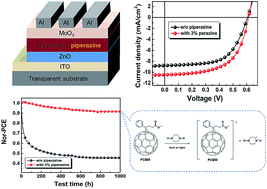Simultaneous performance and stability improvement of polymer:fullerene solar cells by doping with piperazine†
Abstract
High efficiency and performance stability are the two key challenges for polymer solar cells before their commercialization. With the development of high-performance conjugated polymer donors and small-molecule acceptors, the power conversion efficiency (PCE) of polymer solar cells now reaches 17%. A method that can improve the PCE while keeping the high device stability of polymer solar cells is therefore strongly needed. In this paper, we report the use of piperazine as a molecular dopant in the blends of the well-investigated polymer–fullerene solar cell systems, including P3HT:PC61BM, PTB7-Th:PC61BM and PffBT4T-2OD:PC61BM. The results indicate that both the efficiency and stability of these polymer solar cells are improved simultaneously after such a molecular doping process. The electron mobility of the piperazine-doped P3HT:PC61BM film (1.68 × 10−3 cm2 V−1 s−1) was found to be enhanced by almost 10 times in comparison with that of the pristine P3HT:PC61BM film (2.0 × 10−4 cm2 V−1 s−1) by measuring the injection-charge extraction by linearly increasing voltage (i-CELIV) in a metal-insulator-semiconductor (MIS) diode, which is due to the intermolecular electron transfer between piperazine and PC61BM, as confirmed by the dark electron spin resonance (ESR) measurement. In addition, piperazine molecules are able to reduce oxidized P3HT, yielding neutral P3HT, which is considered as the second reason for the performance enhancement. Photon-induced charge transfer between PC61BM and piperazine was confirmed by light electron spin resonance (LESR) measurements. Such a charge transfer process leads to the quenching of PC61BM excitons by piperazine, which decreases the PC61BM dimerization rate and consequently suppresses the “burn-in” degradation of polymer solar cells. The current work provides an effective method that can simultaneously improve the efficiency and stability of polymer–fullerene solar cells.



 Please wait while we load your content...
Please wait while we load your content...